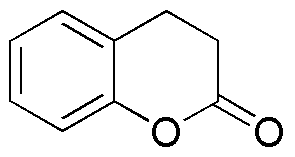Dihydrocoumarin is widely utilized in research focused on:
- Fragrance Industry: Commonly used as a fragrance component in perfumes and cosmetics, providing a sweet, floral scent that enhances product appeal.
- Flavoring Agent: Employed in the food industry as a flavoring agent, particularly in baked goods and confections, to impart a pleasant taste reminiscent of vanilla or caramel.
- Pharmaceuticals: Investigated for its potential therapeutic properties, including anti-inflammatory and antioxidant effects, making it a candidate for drug development.
- Biochemical Research: Utilized in studies related to plant biology and biochemistry, serving as a model compound to understand coumarin derivatives and their biological activities.
- Polymer Chemistry: Incorporated into polymer formulations to enhance material properties, such as UV stability and antimicrobial activity, benefiting industries like packaging and textiles.
General Information
Properties
Safety and Regulations
Applications
Dihydrocoumarin is widely utilized in research focused on:
- Fragrance Industry: Commonly used as a fragrance component in perfumes and cosmetics, providing a sweet, floral scent that enhances product appeal.
- Flavoring Agent: Employed in the food industry as a flavoring agent, particularly in baked goods and confections, to impart a pleasant taste reminiscent of vanilla or caramel.
- Pharmaceuticals: Investigated for its potential therapeutic properties, including anti-inflammatory and antioxidant effects, making it a candidate for drug development.
- Biochemical Research: Utilized in studies related to plant biology and biochemistry, serving as a model compound to understand coumarin derivatives and their biological activities.
- Polymer Chemistry: Incorporated into polymer formulations to enhance material properties, such as UV stability and antimicrobial activity, benefiting industries like packaging and textiles.
Documents
Safety Data Sheets (SDS)
The SDS provides comprehensive safety information on handling, storage, and disposal of the product.
Product Specification (PS)
The PS provides a comprehensive breakdown of the product’s properties, including chemical composition, physical state, purity, and storage requirements. It also details acceptable quality ranges and the product's intended applications.
Certificates of Analysis (COA)
Search for Certificates of Analysis (COA) by entering the products Lot Number. Lot and Batch Numbers can be found on a product’s label following the words ‘Lot’ or ‘Batch’.
*Catalog Number
*Lot Number
Certificates Of Origin (COO)
This COO confirms the country where the product was manufactured, and also details the materials and components used in it and whether it is derived from natural, synthetic, or other specific sources. This certificate may be required for customs, trade, and regulatory compliance.
*Catalog Number
*Lot Number
Safety Data Sheets (SDS)
The SDS provides comprehensive safety information on handling, storage, and disposal of the product.
DownloadProduct Specification (PS)
The PS provides a comprehensive breakdown of the product’s properties, including chemical composition, physical state, purity, and storage requirements. It also details acceptable quality ranges and the product's intended applications.
DownloadCertificates of Analysis (COA)
Search for Certificates of Analysis (COA) by entering the products Lot Number. Lot and Batch Numbers can be found on a product’s label following the words ‘Lot’ or ‘Batch’.
*Catalog Number
*Lot Number
Certificates Of Origin (COO)
This COO confirms the country where the product was manufactured, and also details the materials and components used in it and whether it is derived from natural, synthetic, or other specific sources. This certificate may be required for customs, trade, and regulatory compliance.


